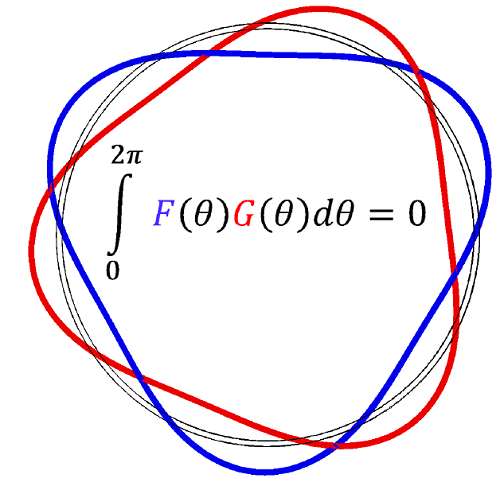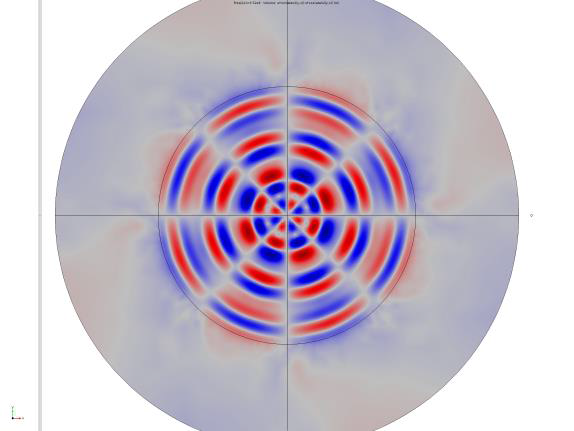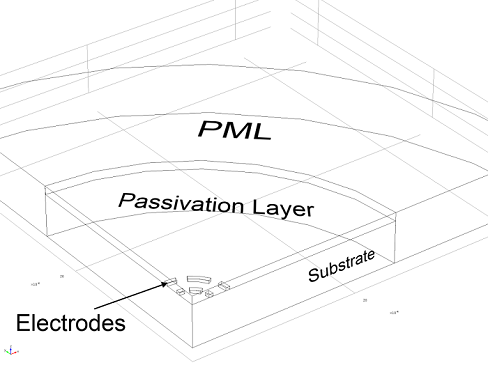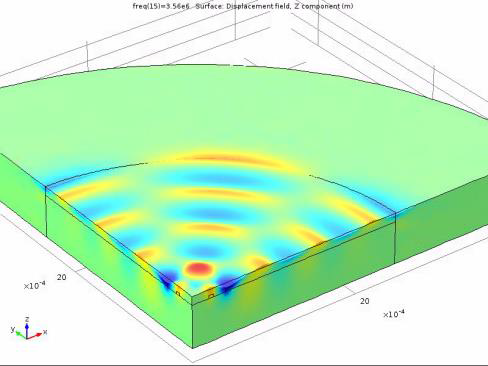
In the paper “Degeneracy Breaking, Modal Symmetry and MEMS Biosensors”, which was presented at the COMSOL Conference 2013 in Rotterdam, researchers experiment with using material and geometric symmetry breaking to design a MEMS biosensor.
Degeneracy Breaking in a MEMS Gyroscope
MEMS gyroscopes are found in a wide range of consumer products, from phones to game consoles to cars. These devices detect the rotation of an object, often using a coupling between motion in two directions at right angles induced by the Coriolis force.

The figure above shows two degenerate modes of a section through a wine glass. The equation is a mathematical expression of the fact that the two modes are orthogonal, or independent of each other. We could construct other degenerate pairs by taking combinations of these two modes that are also orthogonal. They would look similar in form, except for a rotation about the center of the wine glass.
The principle behind degenerate mode sensors was first discovered by the physicist G.H. Bryan when he struck the edge of a wine glass and listened to its vibrations. He found that when the glass was being rotated about its stem, the tone of vibration undulated, which he recognized as beats between two sound waves with slightly different frequencies.
What Bryan had discovered was the symmetry breaking of degenerate modes — two different modes of vibration that resonate at identical frequencies. In vibrating objects that are symmetric, such as Bryan’s wine glass, two degenerate mode pairs exist for every degree of rotation (natural number). When a symmetric object is rotating, Coriolis forces break the symmetry between sound waves generated by the object, splitting their frequencies in proportion to the rate of rotation. Measuring the difference in frequency of the broken degenerate modes can tell us the rate of rotation.
This concept is the principle behind the design of some MEMS gyroscopes. When the symmetry of the system is broken by an environmental factor of interest (in the case of a MEMS gyroscope — the Coriolis force), this change causes degeneracy breaking in the modes of vibration that can be used as a means to sense the environmental factor. However, instead of using the Coriolis force to cause degeneracy breaking, we could use other factors that change the symmetry of the device. For example, selectively adding a small amount of material to a part of the object can alter its symmetry and cause degeneracy breaking. Thus, sensors other than gyroscopes can utilize this principle.
Simulating a MEMS Biosensor
In the paper “Degeneracy Breaking, Modal Symmetry and MEMS Biosensors” by H.T.D. Grigg, T.H. Hanley, and B.J. Gallacher, researchers at Newcastle University in the UK leveraged simulation to investigate the effects of material and geometric symmetry breaking in a degenerate mode sensor, a device designed using the same principles behind the MEMS gyroscopes that operate through degeneracy breaking.
Using COMSOL Multiphysics software, the team designed a degenerate Rayleigh SAW device with a symmetric geometry — that initially had degenerate modes. The surface of the sensor is treated so that an analyte (a substance or chemical of interest) will bind selectively to parts of the device, leading to a non-symmetric mass loading. This induces a frequency split in the degenerate modes.
The vibrational mode used can be seen in an image from their COMSOL Conference presentation:

Image credit: H.T.D. Grigg, T.H. Hanley, B.J. Gallacher, Newcastle University, Newcastle upon Tyne, United Kingdom.
Since the device is symmetric, the researchers used a quarter of the geometry in order to reduce computation time. The images below show how the device was designed using an anisotropic piezoelectric substrate covered by an isotropic layer. This arrangement of materials creates dispersive, anisotropic Rayleigh waves. The device was modeled with the Piezoelectric Devices interface using Frequency Domain and Time Dependent studies in COMSOL Multiphysics. The image below also shows the Perfectly Matched Layer (PML), which the researchers used to simulate a boundary absorber.
In their simulations, the researchers broke the degeneracy of the modes by changing the boundary conditions and/or the material properties in a non-symmetric manner. In a laboratory experiment, the degeneracy would be broken by asymmetric mass loading of the analyte. Because the sensor is symmetric with respect to other environmental factors (such as changes in temperature, etc.), it is generally robust to environmental disturbances — just like the MEMS gyroscopes that operate on the same principle.


Image credit: H.T.D. Grigg, T.H. Hanley, B.J. Gallacher, Newcastle University, Newcastle upon Tyne, United Kingdom.
Further Reading
To learn more about the MEMS biosensor, download the paper and presentation from the COMSOL Conference 2013.




Comments (0)